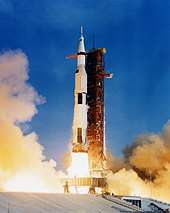Saturn V-B
| Function | Manned/unmanned LEO and Lunar launch vehicle |
|---|---|
| Country of origin | United States |
| Size | |
| Height | 50.00 m (164 ft) |
| Diameter | 10.06 m (33 ft) |
| Mass | 2,313,320 kg (5,099,990 lb) |
| Stages | 1.5 |
| Capacity | |
| Payload to LEO | 22,600 kg (49,800 lb) |
| Launch history | |
| Status | Concept/study |
| Launch sites | N/A |
| Total launches | N/A |
| First stage - S-ID Booster | |
| Engines | 5 Rocketdyne F-1 |
| Thrust | 30,62.500 kN (6,960,647 lbf) |
| Burn time | 154 seconds |
| Fuel | RP-1/LOX |
| Second stage S-ID Sustainer | |
| Engines | 1 Rocketdyne F-1 |
| Thrust | 7,740.300 kN (1,740,089 lbf) |
| Burn time | 315 seconds |
| Fuel | RP-1/LOX |
Studied in 1968 by Marshall Space Flight Center, the Saturn V-B was considered an interesting vehicle concept because it nearly represents a single-stage to orbit booster, but is actually a stage and a half booster just like the Atlas. The booster would achieve liftoff via five regular F-1 engines; four of the five engines on the Saturn V-B would be jettisoned and could be fully recoverable, with the sustainer stage on the rocket continuing the flight into orbit. The rocket could have had a good launch capability similar to that of the Space Shuttle if it was constructed, but it never flew.
This article is issued from
Wikipedia.
The text is licensed under Creative Commons - Attribution - Sharealike.
Additional terms may apply for the media files.
